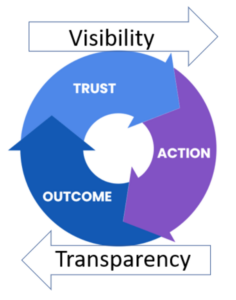Ask anyone what they hope to see coming out of the United Nations Climate Change Conference (COP27) this week and their answer will include the word action.
But taking effective action on climate change, especially in supply chains, requires transparency and cooperation. Cooperation requires clear communication and alignment. And for successful communication and alignment we must not talk past each other. Clarity on words and their definitions matters.
Defining supply chain transparency versus visibility
Two words that will be used as much as any at COP27 this week are visibility and transparency, but they are often used interchangeably or in a generic way, given that both words have meaning outside supply chain management. But when we get specific to the supply chain, each word has a distinct meaning.
This is not the first time these terms have been defined. Many supply chain experts have highlighted the benefits of transparency in the supply chain.
Daniel Stanton, widely known as “Mr. Supply Chain” summarizes that “before you can provide transparency, you need to have visibility…you can’t share with others what you can’t see yourself.”
Alexis Bateman at the MIT Center for Transportation and Logistics breaks supply chain transparency into two elements: visibility and disclosure.
Sheri Hinish, the “Supply Chain Queen,” points out that “transparency doesn’t mean sharing every single detail…[but] sharing the right, accurate info.”
Lora Cecere, founder of Supply Chain Insights reminds us that these definitions “will swirl in the air…teams think that they have agreement, but because they have not clearly defined the terms, they do not have alignment to drive success.”
Lora’s observation hits home: Whatever your exact definition you must start by defining it to those with whom you are communicating. My definitions are short and simple.
Supply chain visibility is the ability to see what you need to be able to see across your extended value chain to make decisions and take action.
Supply chain transparency is sharing information with those outside your immediate sphere of operations or company as necessary to enable them to make decisions and take action.
Why do I define visibility and transparency this way?
- Both definitions end with action. Visibility for visibility’s sake is a poor use of resources.
- I’ve added “as necessary” to emphasize that transparency is not about sharing everything, it is about sharing what is needed to enable another entity to take action.
- Both definitions underline the importance of asking why, and connecting the dots between outcome, insights, and data.
- My definitions are deliberately broad because an inbound logistics manager will have a different view of visibility (or transparency) than the category manager or the CSCO. This also allows “risk visibility” to be made part of overall visibility. Visibility without context is not full visibility.
Benefits of supply chain transparency and company-wide clarity on execution
Whatever your definitions, take the time to hammer them out with your team. With solid definitions in hand a company can:
- Communicate more clearly and align intentions internally and externally.
- Connect intent to collaborative action.
- Clarify data architecture and governance. Transparency and visibility will often be enabled by the same types of data, but the flow is different with different implications.
- Build trust. A key benefit of supply chain transparency is that it fosters trust. When transparency leads to action, and that action leads to better outcomes, it strengthens trust, a vital element in supply chain flows along with physical goods, cash, and information.

The transparency-visibility discussion is not new, but some things have changed in the last two years:
- The necessity of multi-tier visibility, a significant benefit of supply chain transparency, is now widely recognized. Achieving this requires an outside-in approach, driven by both visibility and transparency.
- A growing list of reporting requirements and legislation on climate change and human rights forces companies to obtain better visibility to their supply chains and become more transparent with trading partners, governments, and NGOs.
- Technology now helps companies quickly gain multi-tier visibility and share data in a controlled, transparent, and trusted manner. Those who don’t take this approach will be left behind. Forbes recently highlighted this as one of the Top Supply Chain Trends for 2023.
This isn’t about being a grammarian. But defining the terms matters. Being clear about what we mean by visibility and transparency, what they are and what they are not, makes it easier to communicate, collaborate, and take action.
Get our report to see how to calculate the ROI of supply chain transparency and visibility.